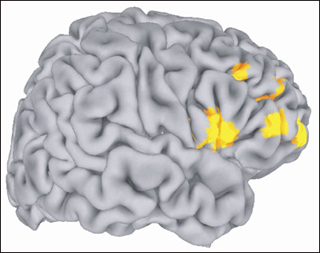
Activity in the highlighted areas in the prefrontal cortex may affect the level of dopamine in the mid-brain, in a finding that has implications for schizophrenia. (Image courtesy of the National Institutes of Mental Health.)
Instructor(s)
Prof. Thomas Byrne
MIT Course Number
9.22J / HST.422J
As Taught In
Fall 2006
Level
Undergraduate
Course Description
Course Description
This course is designed to provide an understanding of how the human brain works in health and disease, and is intended for both the Brain and Cognitive Sciences major and the non-Brain and Cognitive Sciences major. Knowledge of how the human brain works is important for all citizens, and the lessons to be learned have enormous implications for public policy makers and educators.
The course will cover the regional anatomy of the brain and provide an introduction to the cellular function of neurons, synapses and neurotransmitters. Commonly used drugs that alter brain function can be understood through a knowledge of neurotransmitters. Along similar lines, common diseases that illustrate normal brain function will be discussed. Experimental animal studies that reveal how the brain works will be reviewed.
Throughout the seminar we will discuss clinical cases from Dr. Byrne's experience that illustrate brain function; in addition, articles from the scientific literature will be discussed in each class.


